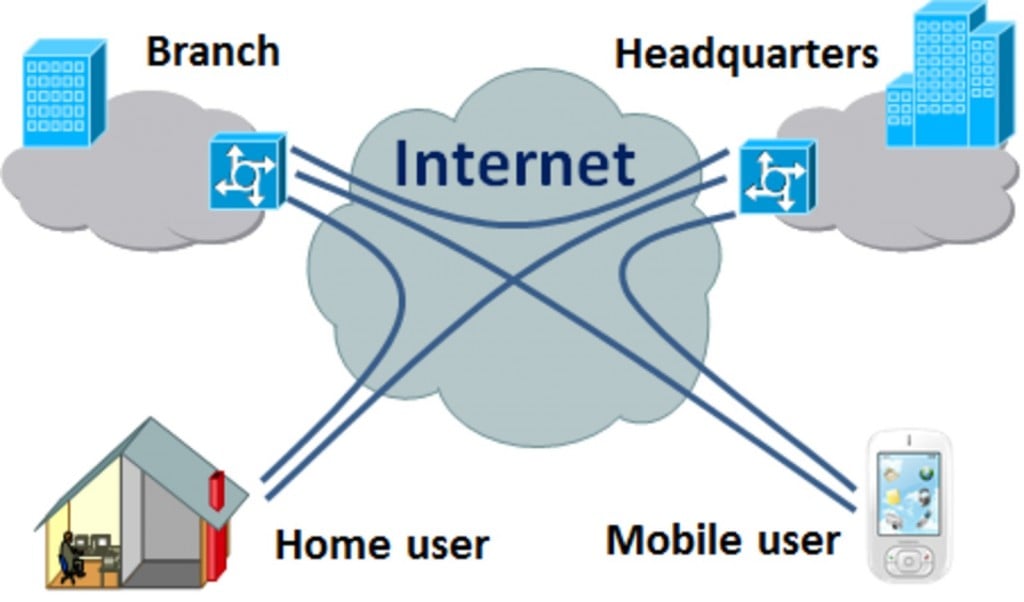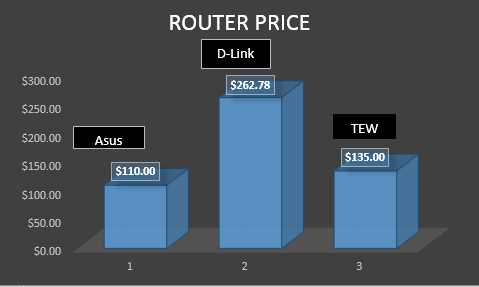Gizmobile Northwest, LLC:
Feasibility Report – Hardware Purchase
Working for a software company presents some really interesting work flows. Because of the cycle of development, testing, and release, the amount of work can go from tremendous, to non existent. When the cycle of work is at its lowest it becomes less important, especially for programmers to actually come into the office. However, even when working from home, they do need access to resources or programs only accessible within the office. Luckily there is a safe, secure way to access network resources from a remote location.
We are looking to expand our network infrastructure and capabilities. Mainly my supervisor wants a Router that has the capabilities of setting up a Virtual Private Network (VPN). A VPN allows for a remote (out of office) user to create a “tunnel” into the office network and access anything that is part of said network, including but not limited to shared files, the office computer’s hard drive, and printers. My supervisor wants a router that at the minimum uses L2TP(layer 2 tunneling protocol) security, at least 100mb(1G preferred) connection ports, and is compatible with current network.
EXECUTIVE SUMMARY:
Tech workers are always looking for chances to upgrade their gadgets, so with the emerging need within the company to have remote secure access to the interoffice network, it is the perfect opportunity to research new hardware. This need of secure remote access will be addressed by setting up a Virtual Private Network (VPN). In order to do that, the company must have the hardware capability to set one up. To that end, this feasibility report will offer three hardware solutions that will enable VPN use: Asus RT-AC56U, D-Link DIR-885L, Trendnet TEW-818DRU Dual Band Wireless Router. This report, additionally, ranked the alternative solutions, according to its security and benefits. Router #3, the TEW-818DRU, is the first recommendation. Router #1, the Asus RT-AC56U, is the second recommendation. Router #2, the D-Link DIR-885L, is the third recommendation.
INTRODUCTION:
As remote access becomes more common in the workplace it is important to maintain security and network policies while implementing a VPN. The best course is to implement security at the point of connection to the network, namely the router. It is with that guideline in mind I investigated several VPN enabled routers and will be presenting the most viable three in this report.
BACKGROUND:
As the use of technology increases in business and personal use, so does the access to valuable information. In the business world, especially for a software company, this can encompass proprietary source code, valuable financial information, and company personal information. When working in an office setting the network used for communication and sharing of this data can, and is tightly controlled and kept secure. Access to the internet, or the Wild as insiders call it, is regulated and monitored on both in and outbound channels. However, when an employee is outside of the office, but needs access to office resources, a connection to the network has to be made somehow.
Without any security measures or policies in place for allowed access to the interoffice network, the data transmitted between the office and the remote employee is easy readable (un-encrypted) and easily accessible for people who are looking for that type of information to steal. With the availability of free and easy to use tools that allow anyone to intercept and view transmitted data, it is incredibly important for businesses to make sure all data transmissions are secure. One of the ways to keep remote access secure is a VPN. A VPN allows for a prearranged, secure connection to be initiated between the remote employee and the office network anytime, anyplace. VPN, however, is the method, a VPN capable router is the tool for the solution, and what this report will focus on.
OUTLINE OF PROJECT:
The goal of the analysis was to find a piece of hardware that would provide the software needed to establish the type of network the company wanted to utilize, namely a VPN. The hardware had to be compatible with our current network, meet the security requirements of the already in place procedures, and provide the software we needed to expand our network.

Example of a expanded business network.
IMAGE: http://theconversation.com/explainer-what-is-a-virtual-private-network-vpn-12741
METHOD OF ANALYSIS:
The amount of routers available on the market can be overwhelming. The first criteria I used to narrow it down was compatibility with our current network and attached hardware. While 100mps was the minimum requirement, 1gps was preferred. Taking price into account, since 1gps is more rare for lower end routers, I decided to aim for that and used 1gps requirement to eliminate quite a few selections.
I knew the third most constrictive requirement was the security measure used for the VPN, using that I was able to pair it down to a very few. Using a max price of $300 I arrived at the three options I included in this report.
Since company resource security, and network speed are the largest concerns when utilizing remote access the rankings of the routers were based on the following criteria, in order of importance:
- VPN capable
- Port Speed and load balancing capabilities
- Compatibility with current network infrastructure
- Price
- User Friendly interface
The user friendly interface will be based on screenshots and user reviews from the following sites: Amazon, Manufacture’s website, Newegg.com, and various forums. These will be compiled into a user rating score for the purpose of comparison.
It should be noted that the criteria of having L2TP security, at least 100mb (1gig preferred) connection ports, and being compatible with our network are not only import but required as part of the hardware specifications.
OVERVIEW OF ALTERNATIVES:
The first Router I looked at was the Asus RT-AC56U, While the cheapest of the bunch, it also had the least amount of overall options. It did rate high on a user rating scale, a 4 out of 5, based on forum reviews, but that was its strongest point, and the least important criteria.
It does offer two types of security protocols for the VPN, but one of them is the weakest offered, and probably wouldn’t be used. It does however have the 1gps preferred port speed, two wireless channels, and is compatible with our current network. It is for these reasons that I think it would make a viable second choice.
The next router I looked at was the D-Link DIR-885L. I knew right away, due to the price that it would be the least feasible of the options. It also was the only one to offer only one option for the VPN protocol. While it is the required one, it is nice to have an alternative, especially since both of the routers under $200.00 offer multiple protocols. It did have the highest user friendly rating score, but as a software company, user friendly is less important than actual network capabilities. It does fit all of the required criteria however, but since it offers very little extra for a significant price increase, it would be the third, and last recommendation.
The third router, and first recommendation is the TEW-818DRU. For very little extra over the cheapest option (Router #1), it offers the most security protocols and highest port speed. Two very important qualities for expanding a network. Beyond that, it matches the other two options in wireless channel speed. While it does have the lowest user friendly rating, the added benefits it does have makes that inconsequential.
Router Image Sources:
TEW-818DRU – Here
D-Link DIR-885L – Here
Asus RT-AC56U – Here
The two tables below help to visually represent the capabilities and flaws of all the options. The first table, Figure 1, is a general comparison of all three choices. Represented is all of major criteria each choice needed to meet in order to be considered.
Router General Comparison:

Table comparing routers, with key statistics highlighted.
IMAGE: Excel 2016
Figure 1
The second table, Figure 2, focuses solely on the price point of the final three contenders. Using Figure 1 as a general overview, Figure 2 is used to really easily highlight that the 2nd option, the D-Link DIR-885L, is significantly more expensive, for very little extra over the other two options.

Table of routers showing variable prices.
IMAGE: Excel 2016
Figure 2
CONCLUSION:
I looked at several viable options that met the minimum requirement of 100mps, however looking at price comparisons I realized it wasn’t that much more expensive for the 1gps, which was the preferred port speed. Once I narrowed my guideline I was able to found three very viable options. They are, for the most part, incredibly similar and beyond price mostly interchangeable.
RECOMMENDATION:
I believe that Router #3, the TEW-818DRU is a very viable option to provide the optimal setup to enable and utilize a VPN. It meets all of the required criteria, is mid-range price wise, compatible with our current network, and has the most available options. However, all of the routers would provide the needed solution for the implementing remote access, but the other two provided less for a similar price, or more expensive.


